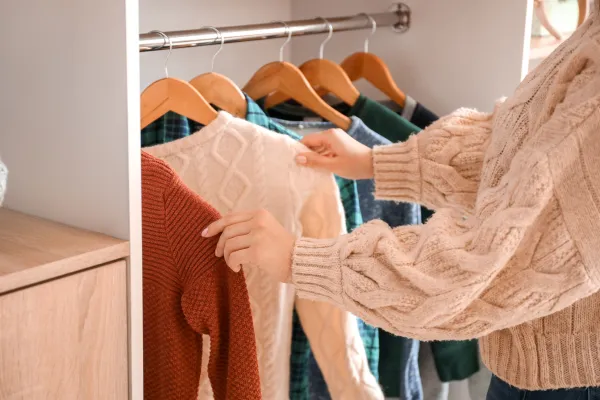
Refreshing Your Wardrobe After Weight Loss (Without Breaking the Bank)
Achieving significant weight loss is a major accomplishment worth celebrating. But that celebration can quickly turn bittersweet when you open your closet and realize nothing fits anymore. While it's a good problem to have, replacing an entire wardrobe can strain even the most carefully planned budget.
As someone who lost a significant amount of weight myself, I faced the simultaneous joy of needing smaller clothes and the panic of figuring out how to afford them. Through trial and error, I discovered numerous strategies to rebuild my wardrobe without emptying my wallet, and even recoup some costs from my now-oversized clothing collection.
Here's my practical guide to refreshing your wardrobe after weight loss while keeping your budget intact.
Out With the Old: Selling Your Current Clothes
Before rushing to fill your closet with new items, let's talk about how to make money from what you already have. Those larger clothes represent an opportunity to fund your new wardrobe.
Online Selling Platforms
Poshmark: Perfect for brand-name and designer items. Poshmark has a social component that rewards active sellers with likes, shares, and followers. The platform takes a flat $2.95 fee for sales under $15 and 20% for anything higher.
Pro tip: Join "Posh Parties" (themed virtual selling events) to increase visibility for your listings.Mercari: Best for everyday, casual clothing. The platform is straightforward with a 10% fee plus a $2 processing fee. Listings require less maintenance than Poshmark but may sell more slowly.
Pro tip: Offer free shipping to make your listings more attractive, but build that cost into your price.eBay: Still the gold standard for selling unique, vintage, or high-end designer pieces. The fee structure is complicated but generally around 10-15% total.
Pro tip: Use the "sold items" filter when researching to see what similar items actually sold for, not just what sellers are asking.
Facebook Marketplace: Best for local sales with no shipping hassle. There are no fees, but you'll need to meet buyers in person.
Pro tip: List in local buy/sell/trade groups specific to your area or even weight loss groups where others might be looking for your size.
Local Options

Consignment Shops: These stores will sell your items and give you a percentage, typically 40-60% of the selling price.
Pro tip: Different consignment shops specialize in different styles and price points. Research the right ones for your particular clothing.Buffalo Exchange and Plato's Closet: These chains buy clothes directly from you on the spot, though they're selective and offer relatively low payouts (about 25-30% of what they'll sell them for).
Pro tip: These stores buy seasonally, so bring summer clothes in spring, not fall.ThredUP Clean Out Kit: They'll send you a bag, you fill it, and they buy what they can sell. It's convenient but offers the lowest return on your investment.
Pro tip: Their "Return Assurance" option costs $14.99 but allows you to get unsold items back rather than having them donated.
Maximizing Your Selling Success

Presentation matters: Clean, pressed clothes with no visible wear sell faster and for more money.
Photograph well: Use natural light, show the item from multiple angles, and include close-ups of special features or fabric.
Write detailed descriptions: Include measurements, fabric content, and original retail price.
Be honest about condition: Note any flaws, because buyers will find them anyway and leave negative feedback if you're not upfront.
Price strategically: Start about 50-70% below retail for used items in excellent condition.
Bundle and save: List multiple items simultaneously to attract more buyers and offer bundle discounts.
In With the New: Budget-Friendly Wardrobe Building
Now that you've generated some cash from your old clothes, let's look at smart ways to build your new wardrobe without overspending. Coincidentally, a lot of the budget-friendly options may be the same places you sold your
Secondhand Sources
Thrift Stores: The classic budget option, with complete unpredictability but potential for amazing finds.
Pro tip: Visit thrift stores in affluent neighborhoods for higher-quality donations.Consignment Stores: More curated than thrift stores, with higher quality but also higher prices.
Pro tip: Many consignment shops have seasonal sales or regular discount days—ask about their schedule.Online Secondhand: Platforms like ThredUP, Poshmark, and Mercari work both ways—you can buy as well as sell.
Pro tip: Save searches for your size and favorite brands to get notifications when new items are listed.Clothing Swap Parties: Organize with friends who have also changed sizes or simply want to refresh their wardrobes.
Pro tip: Set guidelines in advance about condition, approximate value, and number of items to ensure everyone feels the exchange is fair.
Retail Strategies (When You Need New)

Outlet Stores: Factory outlets for your favorite brands can offer significant savings.
Pro tip: Sign up for outlet mall mailing lists to be notified of special events and additional discounts.End-of-Season Clearance: The best time to buy summer clothes is August/September and winter clothes in January/February.
Pro tip: Buy classic pieces on clearance, not trendy items that may look dated by next season.Discount Retailers: TJ Maxx, Marshall's, Ross, and similar stores offer brand names at reduced prices.
Pro tip: Visit regularly as inventory changes quickly.
Strategic Wardrobe Building
When rebuilding after weight loss, strategic planning helps maximize your budget and ensure versatility.
The Capsule Wardrobe Approach
Instead of replacing everything at once, focus on a small collection of versatile pieces:
2 pairs of well-fitting jeans
1 pair of neutral dress pants or skirt
5-7 tops that can be layered and mixed
1 blazer or structured jacket
1 cardigan or casual jacket
1 versatile dress
2 pairs of shoes (casual and dressier)
Pro tip: Choose a consistent color palette so everything coordinates, maximizing outfit combinations.
Strategic Interim Solutions
Belt it: Sometimes a belt can give oversized clothes new life temporarily.
Alterations: Some favorite items can be taken in by a tailor for less than buying new.
Stretchy fabrics: Items with some stretch will accommodate minor size fluctuations.
Final Thoughts: Celebrating Your Journey
Rebuilding your wardrobe after weight loss is a process. Be patient and enjoy discovering your new style. Keep a few "before" clothes as a reminder of your progress, but don’t hold onto too many "just in case." Trust your commitment to your healthier lifestyle.
Ready to feel your best? Start your wellness journey with Valor Wellness and Longevity Clinic. Schedule an appointment with us today.

